Influence of Chabazite Zeolite Foliar Applications Used for Olive Fruit Fly Control on Volatile Organic Compound Emission, Photosynthesis, and Quality of Extra Virgin Olive Oil
Abstract
1. Introduction
2. Results
2.1. Photosynthetic Rate and Leaf Analyses
2.2. BVOC Emissions on Leaves and Fruits
2.2.1. Leaves
2.2.2. Olives
2.3. Fruit Analysis
2.4. Climatic, Soil Data, and Flight Curve
2.5. Chemical and Sensory Analyses of Olive Oils
3. Discussion
4. Materials and Methods
4.1. Field Site and Treatments
4.2. Climatic, Soil Data, and Flight Curve
4.3. Photosynthetic Rate and Leaf Analyses
4.4. BVOC Emissions on Leaves and Fruits
4.5. Fruit Analysis
4.6. Olive Processing and Olive Analysis
4.7. Statistical Analysis
5. Conclusions
Supplementary Materials
Author Contributions
Funding
Data Availability Statement
Acknowledgments
Conflicts of Interest
References
- Daane, K.M.; Johnson, M.W. Olive fruit fly: Managing an ancient pest in modern times. Annu. Rev. Entomol. 2010, 55, 151–169. [Google Scholar] [CrossRef] [PubMed]
- Neuenschwander, P.; Michelakis, S. The infestation of Dacus oleae (Gmel.) (Diptera, Tephritidae) at harvest time and its influence on yield and quality of olive oil in Crete. Z. Angew. Entomol. 1978, 86, 420–433. [Google Scholar] [CrossRef]
- Pereira, J.A.; Alves, M.R.; Casal, S.; Oliveira, B. Effect of olive fruit fly infestation on the quality of olive oil from cultivars Cobrançosa, Madural and Verdeal Transmontana. Ital. J. Food Sci. 2004, 16, 355–365. [Google Scholar]
- Malheiro, R.; Casal, S.; Baptista, P.; Pereira, J.A. A review of Bactrocera oleae (Rossi) impact in olive products: From the tree to the table. Trends Food Sci. Technol. 2015, 44, 226–242. [Google Scholar] [CrossRef]
- Iannotta, N.; Belfiore, T.; Brandmayr, P.; Scalercio, S. The effects of treatments against Bactrocera oleae (Gmelin) on the entomo-fauna of the olive ecosystem. IOBC/WPRS Bull. 2007. [Google Scholar]
- Chen, H.F.; Lin, Y.J.; Chen, B.H.; Yoshiyuki, I.; Liou, S.; Huang, R.T. A Further Investigation of NH4+ Removal Mechanisms by Using Natural and Synthetic Zeolites in Different Concentrations and Temperatures. Minerals 2018, 8, 499. [Google Scholar] [CrossRef]
- Cheng, Q.; Li, H.; Xu, Y.; Chen, S.; Liao, Y.; Deng, F.; Li, J. Study on the adsorption of nitrogen and phosphorus from biogas slurry by NaCl-modified zeolite. PLoS ONE 2017, 12, e0176109. [Google Scholar] [CrossRef]
- Galamini, G.; Ferretti, G.; Medoro, V.; Tescaro, N.; Faccini, B.; Coltorti, M. Isotherms, kinetics, and thermodynamics of NH4+ adsorption in raw liquid manure by using natural chabazite zeolite-rich tuff. Water 2020, 12, 2944. [Google Scholar] [CrossRef]
- Jha, V.K.; Hayashi, S. Modification on natural clinoptilolite zeolite for its NH4+ retention capacity. J. Hazard. Mater. 2009, 169, 29–35. [Google Scholar] [CrossRef]
- De Smedt, C.; Someus, E.; Spanoghe, P. Potential and actual uses of zeolites in crop protection. Pest Manag. Sci. 2015, 71, 1355–1367. [Google Scholar] [CrossRef]
- Moale, C.; Ghiurea, M.; Sirbu, C.E.; Somoghi, R.; Cioroianu, T.M.; Faraon, V.A.; Lupu, C.; Tricab, A.D.C.; Oancea, F. Effects of siliceous natural nanomaterials applied in combination with foliar fertilizers on physiology, yield and fruit quality of the apricot and peach trees. J. Plants 2021, 10, 2395. [Google Scholar] [CrossRef] [PubMed]
- Soca, M.; Daza, M. Evaluation of particle size fractions and doses of zeolite for agriculture. Agrociencia 2016, 50, 965–976. [Google Scholar]
- Paul, M.J.; Foyer, C.H. Sink regulation of photosynthesis. J. Exp. Bot. 2001, 52, 1383–1400. [Google Scholar] [CrossRef] [PubMed]
- Boussadia, O.; Steppe, K.; Zgallai, H.; El Hadj, S.B.; Braham, M.; Lemeur, R.; Van Labeke, M.C. Effects of nitrogen deficiency on leaf photosynthesis, carbohydrate status and biomass production in two olive cultivars ‘Meski’and ‘Koroneiki’. Sci. Hortic. 2010, 123, 336–342. [Google Scholar] [CrossRef]
- Makino, A.; Osmond, B. Effects of nitrogen nutrition on nitrogen partitioning between chloroplasts and mitochondria in pea and wheat. Plant Physiol. 1991, 96, 355–362. [Google Scholar] [CrossRef] [PubMed]
- Fernández-Escobar, R.; Marin, L.; Sánchez-Zamora, M.A.; García-Novelo, J.M.; Molina Soria, C.; Parra, M.A. Long-term effects of N fertilization on cropping and growth of olive trees and on N accumulation in soil profile. Eur. J. Agron. 2009, 31, 223–232. [Google Scholar] [CrossRef]
- Calzarano, F.; Valentini, G.; Arfelli, G.; Seghetti, L.; Manetta, A.C.; Metruccio, E.G.; Di Marco, S. Activity of Italian natural chabasite-rich zeolitites against grey mould, sour rot and gravepine moth, and effects on grape and wine composition. Phytopathol. Mediterr. 2019, 58, 307–321. [Google Scholar]
- Glenn, D.M.; Puterka, G.J.; Vanderzwet, T.; Byers, R.E.; Feldhake, C. Hydrophobic particle films: A new paradigm for suppression of arthropod pests and plant diseases. J. Econ. Entomol. 1999, 92, 759–771. [Google Scholar] [CrossRef]
- Brito, C.; Dinis, L.; Moutinho-Pereira, J.; Correia, C. Kaolin, an emerging tool to alleviate the effects of abiotic stresses on crop performance. Sci. Hortic. 2019, 250, 310–316. [Google Scholar] [CrossRef]
- Donati, F.; Bertin, S.; Gentili, S.; Luigi, M.; Taglienti, A.; Manglli, A.; Tiberini, A.; Barsili, E.; Sciubba, F.; Pascqua, G.; et al. Effect of organic biostimulants added with zelite on zucchini squash plants infected by tomato leaf curl Dew Delhi. Viruses 2022, 14, 607. [Google Scholar] [CrossRef]
- Baratella, V. Development of a Continuous Small-Rearing Technique on Natural Host for the Olive Fruit Fly Bactrocera Oleae (Rossi) and Study on Volatile Organic Compounds (VOCs) Emitted by Olea europaea L. as Potential Host Allelochemics. Ph.D. Thesis, Università degli Studi della Tuscia, Viterbo, Italy, 2011. [Google Scholar]
- Baratella, V.; Volpe, D.; Marucchini, C.; Pucci, C. Early attempts to detect VOCs emission from Olea europaea L. (Laurales: Oleaceae) in different phenological growth stages. IOBC/WPRS Bull. 2012, 74, 233–240. [Google Scholar]
- Campeol, E.; Flamini, G.; Chericoni, S.; Catalano, S. Volatile compounds from three cultivars of Olea europaea from Italy. J. Agric. Food Chem. 2001, 49, 5409–5411. [Google Scholar] [CrossRef]
- Morrone, L.; Vagnoni, E.; Di Virgilio, N.; Neri, L.; Rapparini, F.; Bertazza, G.; Duce, P.; Rotondi, A. Chemical profiling of Bosana virgin olive oils produced in different areas of Sardinia. J. Am. Oil Chem. Soc. 2020, 97, 1119–1129. [Google Scholar] [CrossRef]
- Caselli, A.; Francini, A.; Minnocci, A.; Petacchi, R. Dasineura oleae: Morphological and physiological characterization following the midge attack on olive leaves. J. Plant Dis. Prot. 2021, 128, 173–182. [Google Scholar] [CrossRef]
- Loreto, F.; Schnitzler, J.P. Abiotic stresses and induced BVOCs. Trends Plant Sci. 2010, 15, 154–166. [Google Scholar] [CrossRef]
- Peñuelas, J.; Llusià, J. BVOCs: Plant defense against climate warming? Trends Plant Sci. 2003, 8, 105–109. [Google Scholar] [CrossRef]
- Llusia, J.; Penuelas, J.; Gimeno, B.S. Seasonal and species-specific response of VOC emissions by Mediterranean woody plant to elevated ozone concentrations. Atmos. Environ. 2002, 36, 3931–3938. [Google Scholar] [CrossRef]
- Scarpati, M.L.; Lo Scalzo, R.; Vita, G. Olea europea volatiles attractive and repellent to the olive fruit fly. J. Chem. Ecol. 1993, 19, 881–891. [Google Scholar] [CrossRef]
- Giunti, G.; Campolo, O.; Laudani, F.; Algeri, G.M.; Palmeri, V. Olive fruit volatiles route intraspecific interactions and chemotaxis in Bactrocera oleae (Rossi) (Diptera: Tephritidae) females. Sci. Rep. 2020, 10, 1666. [Google Scholar] [CrossRef]
- Flamini, G.; Cioni, P.L.; Morelli, I. Volatiles from leaves, fruits, and virgin oil from Olea europaea Cv. Olivastra Seggianese from Italy. J. Agric. Food Chem. 2003, 51, 1382–1386. [Google Scholar] [CrossRef] [PubMed]
- Ben Abdeljelil, Z.; Tekaya, M.; Mechri, B.; Flamini, G.; Hammami, M. Changes in volatiles of olive tree Olea europaea according to season and foliar fertilization. Int. J. Agric. Biol. 2017, 19, 1633–1639. [Google Scholar]
- Malheiro, R.; Casal, S.; Cunha, S.C.; Baptista, P.; Pereira, J.A. Identification of leaf volatiles from olive (Olea europaea) and their possible role in the ovipositional preferences of olive fly, Bactrocera oleae (Rossi) (Diptera: Tephritidae). Phytochemistry 2016, 121, 11–19. [Google Scholar] [CrossRef] [PubMed]
- Heiden, A.C.; Kobel, K.; Komenda, M.; Koppmann, R.; Shao, M.; Wildt, J. Toluene emissions from plants. Geophys. Res. Lett. 1999, 26, 1283–1286. [Google Scholar] [CrossRef]
- Alfonso, I.; Vacas, S.; Primo, J. Role of α-copaene in the susceptibility of olive fruits to Bactrocera oleae (Rossi). J. Agric. Food Chem. 2014, 62, 11976–11979. [Google Scholar] [CrossRef] [PubMed]
- Wildt, J.; Kobel, K.; Schuh-Thomas, G.; Heiden, A.C. Emissions of oxygenated volatile organic compounds from plants Part II: Emissions of saturated aldehydes. J. Atmos. Chem. 2003, 45, 173–196. [Google Scholar] [CrossRef]
- Beck, J.J.; Higbee, B.S.; Gee, W.S.; Dragull, K. Ambient orchard volatiles from California almonds. Phytochem. Lett. 2011, 4, 199–202. [Google Scholar] [CrossRef]
- Misztal, P.K.; Hewitt, C.N.; Wildt, J.; Blande, J.D.; Eller, A.S.; Fares, S.; Gentner, D.R.; Gilman, J.B.; Graus, M.; Greenberg, J.; et al. Atmospheric benzenoid emissions from plants rival those from fossil fuels. Sci. Rep. 2015, 5, 12064. [Google Scholar] [CrossRef]
- Pagadala Damodaram, K.J.; Gadad, H.S.; Parepally, S.K.; Vaddi, S.; Ramanna Hunashikatti, L.; Bhat, R.M. Low moisture stress influences plant volatile emissions affecting herbivore interactions in tomato, Solanum lycopersicum. Ecol. Entomol. 2021, 46, 637–650. [Google Scholar] [CrossRef]
- Xiao, Y.Y.; Qian, J.J.; Hou, X.L.; Zeng, L.T.; Xu, L.I.U.; Mei, G.G.; Liao, Y.Y. Diurnal emission of herbivore-induced (Z)-3-hexenyl acetate and allo-ocimene activates sweet potato defense responses to sweet potato weevils. J. Integr. Agric. 2023, 22, 1782–1796. [Google Scholar] [CrossRef]
- Singh, S.K.; Strobel, G.A.; Knighton, B.; Geary, B.; Sears, J.; Ezra, D. An endophytic Phomopsis sp. possessing bioactivity and fuel potential with its volatile organic compounds. Microb. Ecol. 2011, 61, 729–739. [Google Scholar] [CrossRef]
- Hu, B.; Jarosch, A.M.; Gauder, M.; Graeff-Hoenninger, S.; Schnitzler, J.P.; Grote, R.; Rennenberg, H.; Kreuzwieser, J. VOC emissions and carbon balance of two bioenergy plantations in response to nitrogen fertilization: A comparison of Miscanthus and Salix. Environ. Pollut. 2018, 237, 205–217. [Google Scholar] [CrossRef] [PubMed]
- Huang, X.; Lai, J.; Liu, Y.; Zheng, L.; Fang, X.; Song, W.; Yi, Z. Biogenic volatile organic compound emissions from Pinus massoniana and Schima superba seedlings: Their responses to foliar and soil application of nitrogen. Sci. Total Environ. 2020, 705, 135761. [Google Scholar] [CrossRef] [PubMed]
- Proietti, P.; Nasini, L.; Balducci, M.A.; Famiani, F.; Ilarioni, L. Effetti dulla concimazione fogliare azotata sull’attività dell’olivo e sulla qualità del suolo. Acta It. Hort. 2009, 1, 51–55. [Google Scholar]
- Regni, L.; Proietti, P. Effects of nitrogen foliar fertilization on the vegetative and productive performance of the olive tree and on oil quality. Agriculture 2019, 9, 252. [Google Scholar] [CrossRef]
- Rotondi, A.; Bertazza, G.; Faccini, B.; Ferretti, G.; Morrone, L. Effect of different foliar particle films (kaolin and zeolitite) on chemical and sensory properties of olive oil. Agronomy 2022, 12, 3088. [Google Scholar] [CrossRef]
- Angerosa, F.; Di Giacinto, L.; Solinas, M. Influence of Dacus oleae infestation on flavor of oils, extracted from attacked olive fruits, by HPLC and HRGC analyses of volatile compounds. Grasas Aceites 1992, 43, 134–142. [Google Scholar] [CrossRef]
- Sinno, M.; Bézier, A.; Vinale, F.; Giron, D.; Laudonia, S.; Garonna, A.P.; Pennacchio, F. Symbiosis disruption in the olive fruit fly, Bactrocera oleae (Rossi), as a potential tool for sustainable control. Pest Manag. Sci. 2020, 76, 3199–3207. [Google Scholar] [CrossRef] [PubMed]
- Brito, C.; Dinis, L.T.; Silva, E.; Goncalves, A.; Matos, C.; Rodrigues, M.A.; Moutinho-Pereira, J.; Barros, A.; Correia, C. Kaolin and salicylic acid foliar application modulate yield, quality and phytochemical composition of olive pulp and oil from rainfed trees. Sci. Hortic. 2018, 237, 176–183. [Google Scholar] [CrossRef]
- Servili, M.; Esposto, S.; Veneziani, G.; Urbani, S.; Taticchi, A.; Di Maio, I.; Selvaggini, R.; Sordini, B.; Montedoro, G.F. Improvement of bioactive phenol content in virgin olive oil with an olive-vegetation water concentrate produced by membrane treatment. Food Chem. 2011, 124, 1308–1315. [Google Scholar] [CrossRef]
- Galamini, G.; Ferretti, G.; Rosinger, C.; Huber, S.; Medoro, V.; Mentler, A.; Díaz-Pinés, E.; Gorfer, M.; Faccini, B.; Keiblinger, K.M. Recycling nitrogen from liquid digestate via novel reactive struvite and zeolite minerals to mitigate agricultural pollution. Chemosphere 2023, 317, 137881. [Google Scholar] [CrossRef]
- Medoro, V.; Ferretti, G.; Galamini, G.; Rotondi, A.; Morrone, L.; Faccini, B.; Coltorti, M. Reducing nitrogen fertilization in olive growing by the use of natural chabazite-zeolitite as soil improver. Land 2022, 11, 1471. [Google Scholar] [CrossRef]
- Denaxa, N.K.; Roussos, P.A.; Damvakaris, T.; Stournaras, V. Comparative effects of exogenous glycine betaine, kaolin clay particles and Ambiol on photosynthesis, leaf sclerophylly indexes and heat load of olive cv. Chondrolia Chalkidikis under drought. Sci. Hortic. 2012, 137, 87–94. [Google Scholar] [CrossRef]
- Jifon, J.L.; Syvertsen, J.P. Moderate shade can increase net gas exchange and reduce photoinhibition in citrus leaves. Tree Physiol. 2003, 23, 119–127. [Google Scholar] [CrossRef]
- Larbi, A.; Vazquez, S.; El-Jendoubi, H.; Msallem, M.; Abadia, J.; Abadia, A.; Morales, F. Canopy light heterogeneity drives leaf anatomical, eco-physiological, and photosynthetic changes in olive trees grown in a high-density plantation. Photosynth. Res. 2015, 123, 141–155. [Google Scholar] [CrossRef]
- Yuan, X.; Calatayud, V.; Gao, F.; Fares, S.; Paoletti, E.; Tian, Y.; Feng, Z. Interaction of drought and ozone exposure on isoprene emission from extensively cultivated poplar. Plant Cell Environ. 2016, 39, 2276–2287. [Google Scholar] [CrossRef]
- Baraldi, R.; Neri, L.; Costa, F.; Facini, O.; Rapparini, F.; Carriero, G. Ecophysiological and micromorphological characterization of green roof vegetation for urban mitigation. Urban For. Urban Green. 2019, 37, 24–32. [Google Scholar] [CrossRef]
- Uceda, M.; Hermoso, M. La calidad del aceite de oliva. In El Cultivo del Olivo; Barranco, D., Fernández-Escobar, R., Rallo, L., Eds.; Mundi-Prensa: Madrid, Spain, 1998; pp. 699–728. [Google Scholar]
- Rodrigues, M.A.; Coelho, V.; Arrobas, M.; Gouveia, E.; Raimundo, S.; Correia, C.M.; Bento, A. The effect of nitrogen fertilization on the incidence of olive fruit fly, olive leaf spot and olive anthracnose in two olive cultivars grown in rainfed conditions. Sci. Hortic. 2019, 256, 108658. [Google Scholar] [CrossRef]
- Bendini, A.; Cerretani, L.; Di Virgilio, F.; Belloni, P.; Lercker, G.; Toschi, T.G. In-process monitoring in industrial olive mill by means of FT-NIR. Eur. J. Lipid Sci. Technol. 2007, 109, 498–504. [Google Scholar] [CrossRef]
- EEC. Commission regulation (EEC) No 2568/91 of 1July of 1991 on the characteristics of olive oil and olive-residue oil and on the relevant methods of analysis. Off. J. Eur. Comm. 1991, L248, 1–114. [Google Scholar]
- Morrone, L.; Pupillo, S.; Neri, L.; Bertazza, G.; Magli, M.; Rotondi, A. Influence of olive ripening degree and crusher typology on chemical and sensory characteristics of Correggiolo virgin olive oil. J. Sci. Food Agric. 2017, 97, 1443–1450. [Google Scholar] [CrossRef]
- Cerretani, L.; Bendini, A.; Biguzzi, B.; Lercker, G.; Gallina Toschi, T. Stabilità ossidativa di oli extravergini di oliva ottenuti con diversi impianti tecnologici. Ind. Aliment. 2003, 42, 706–711. [Google Scholar]
- Rotondi, A.; Bendini, A.; Cerretani, L.; Mari, M.; Lercker, G.; Toschi, T.G. Effect of olive ripening degree on the oxidative stability and organoleptic properties of cv. Nostrana di Brisighella extra virgin olive oil. J. Agric. Food Chem. 2004, 52, 3649–3654. [Google Scholar] [CrossRef] [PubMed]
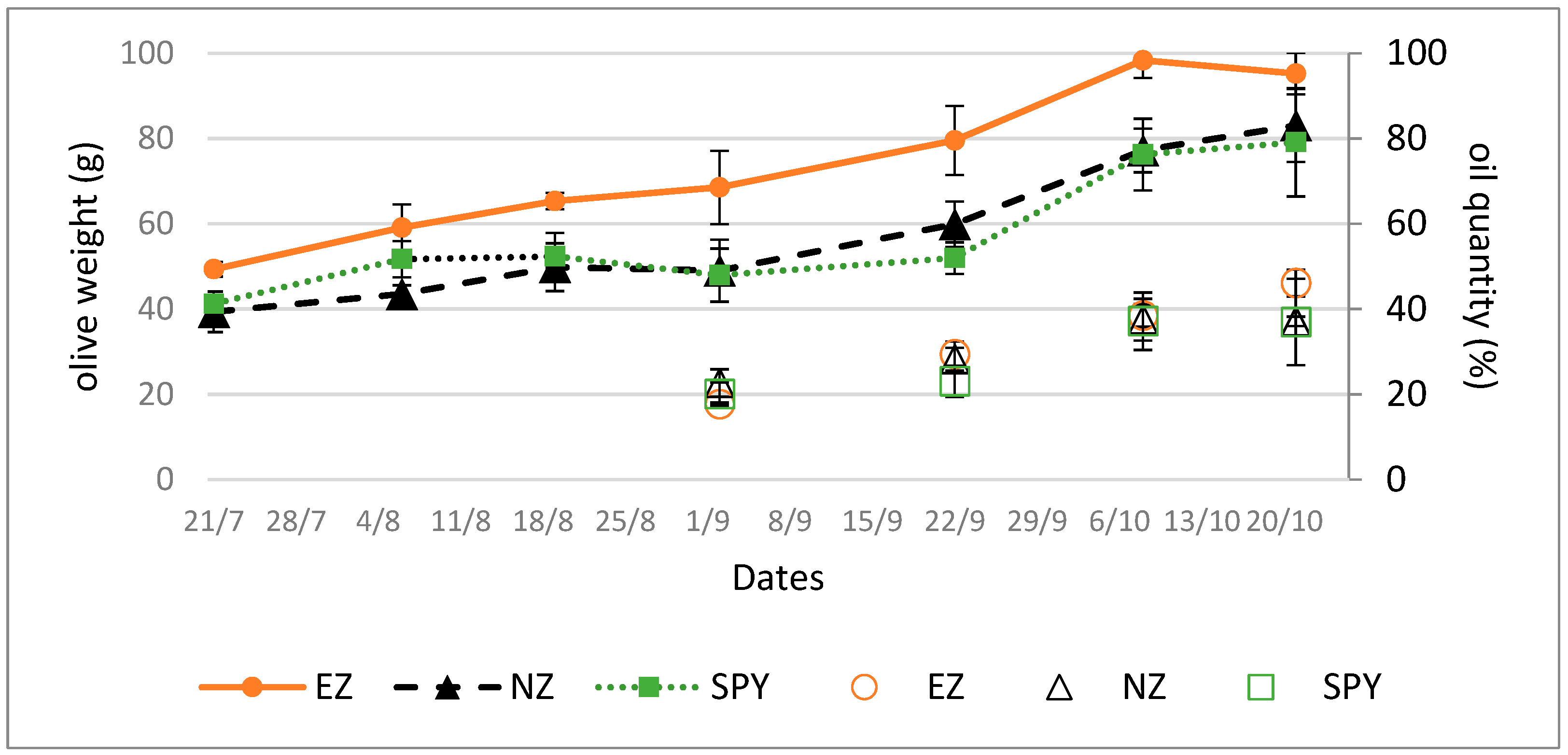
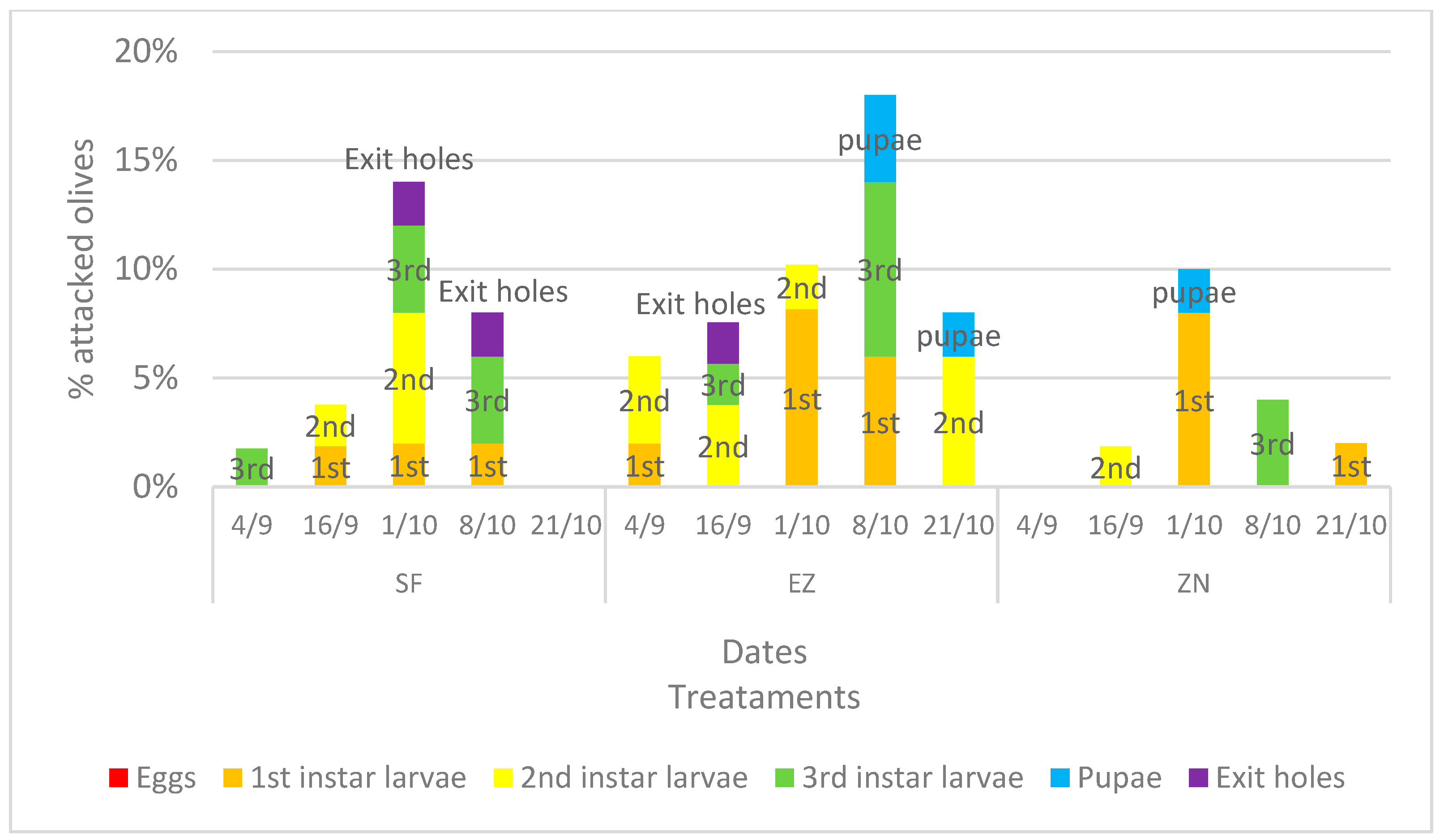
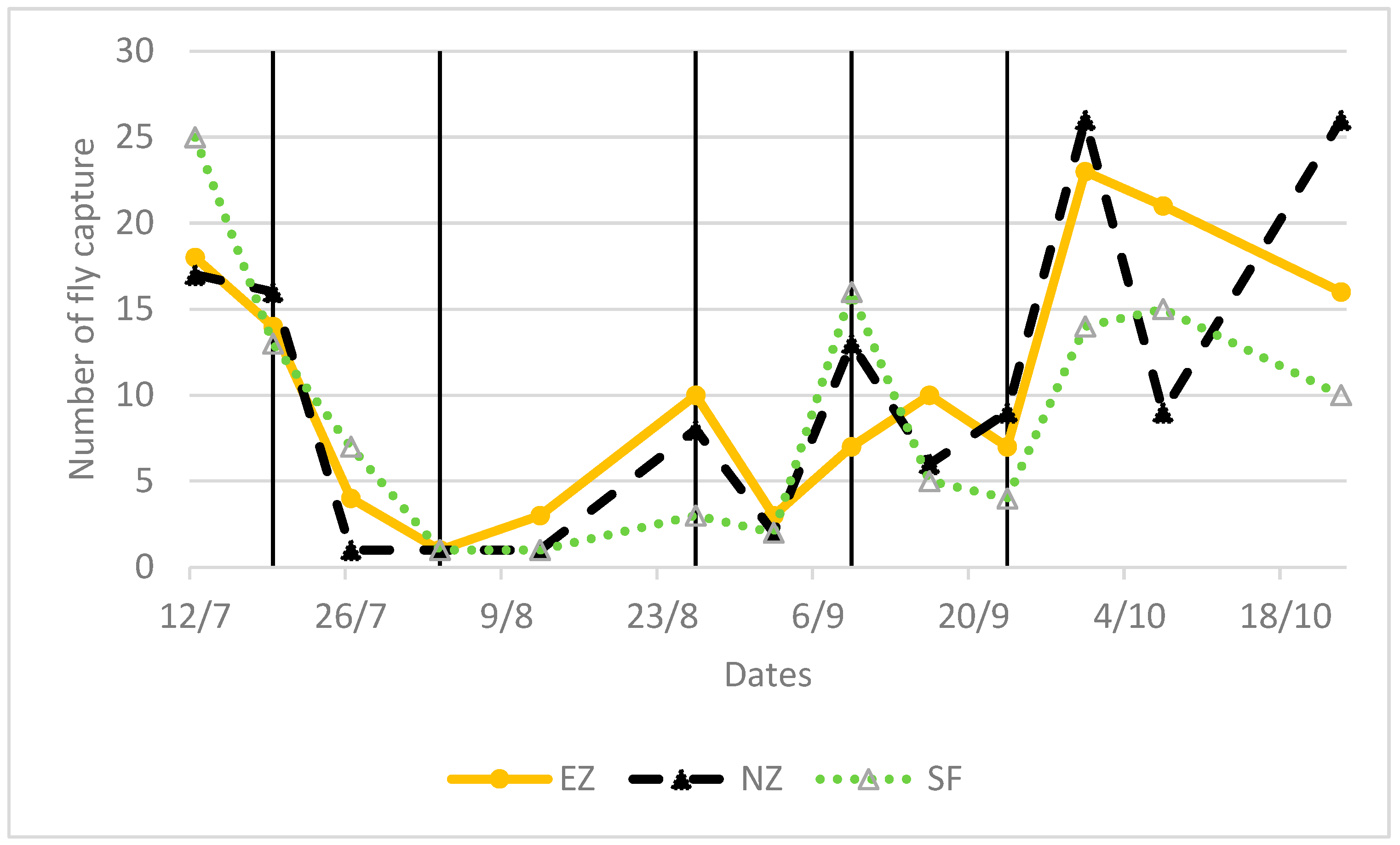
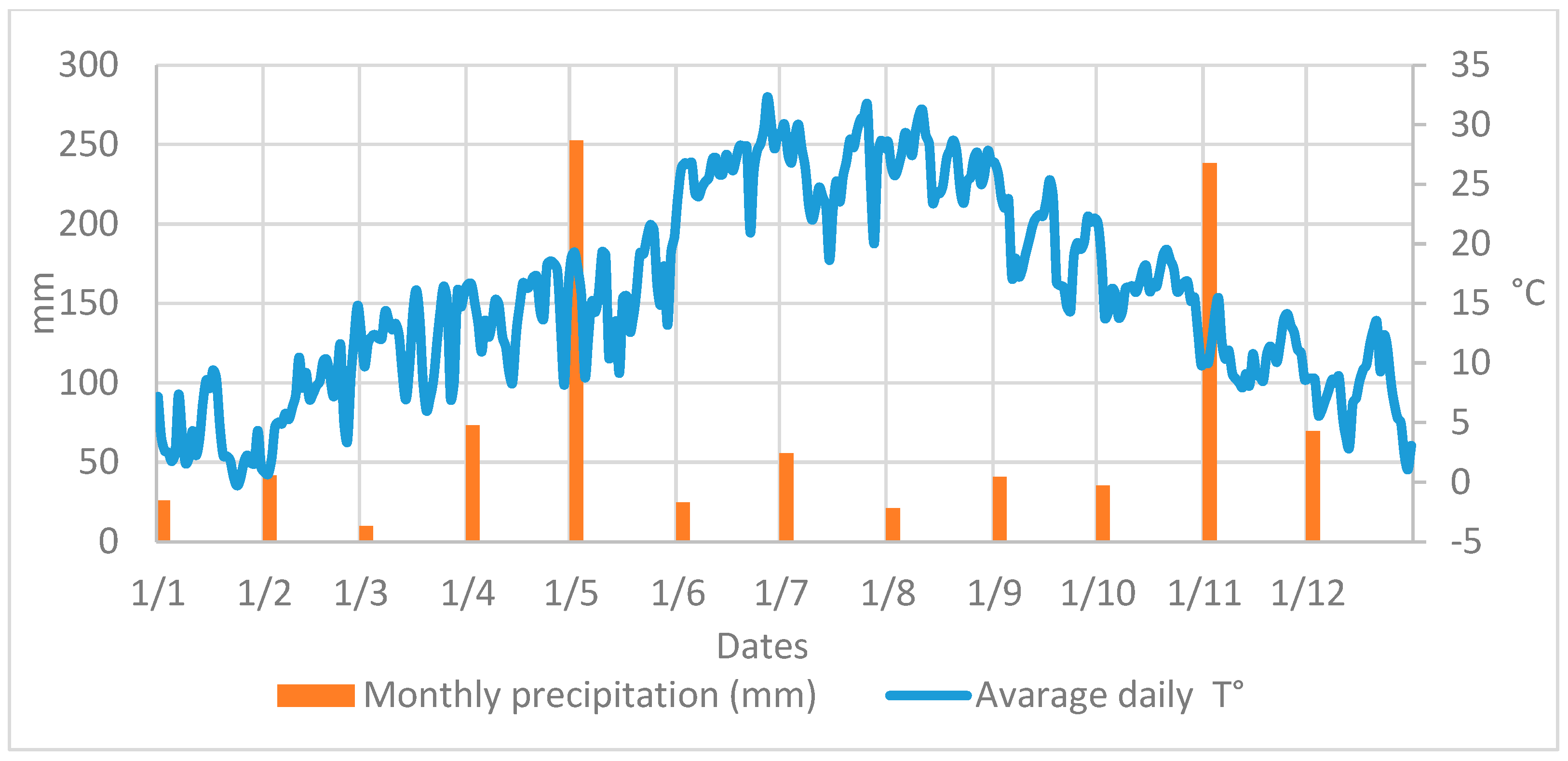
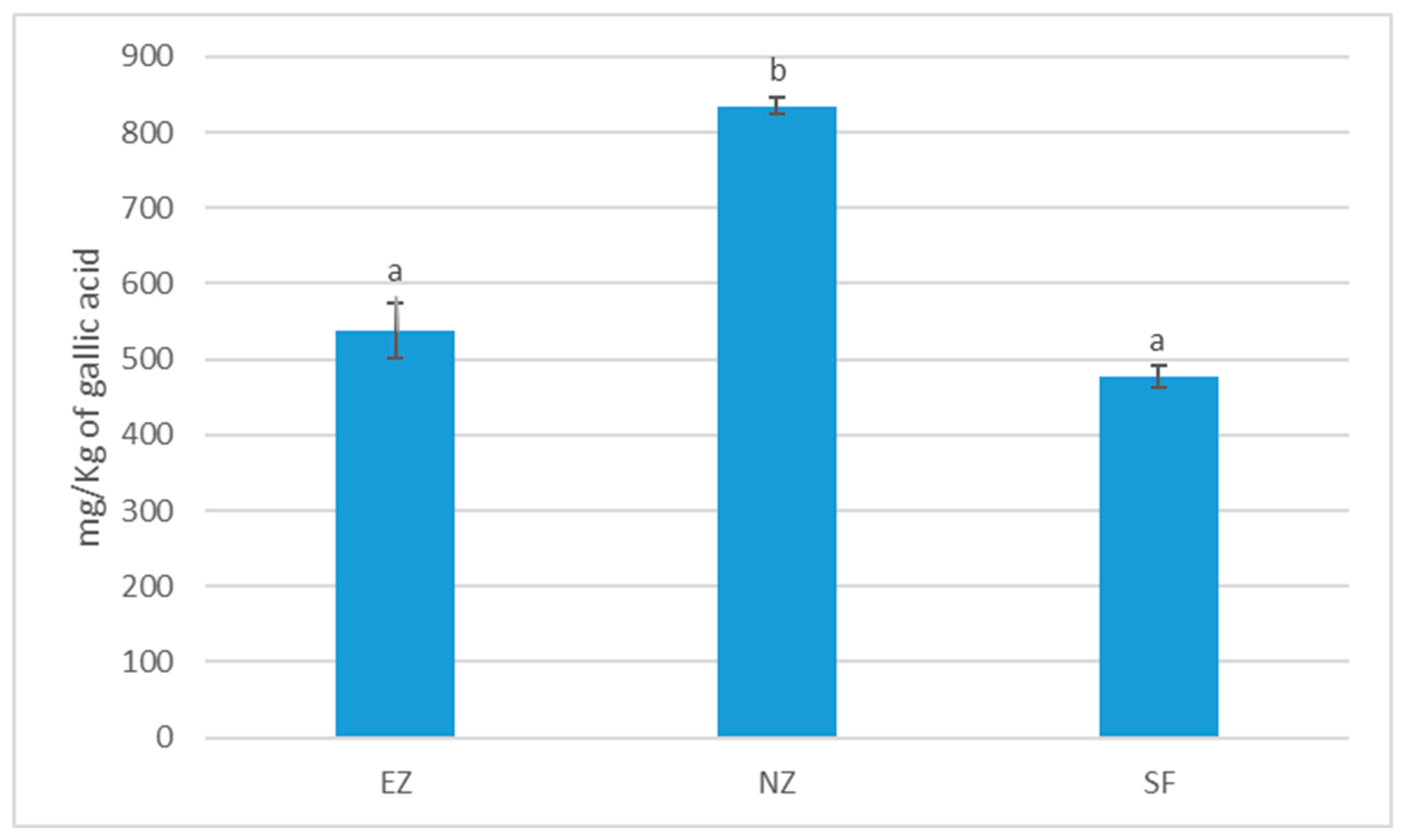
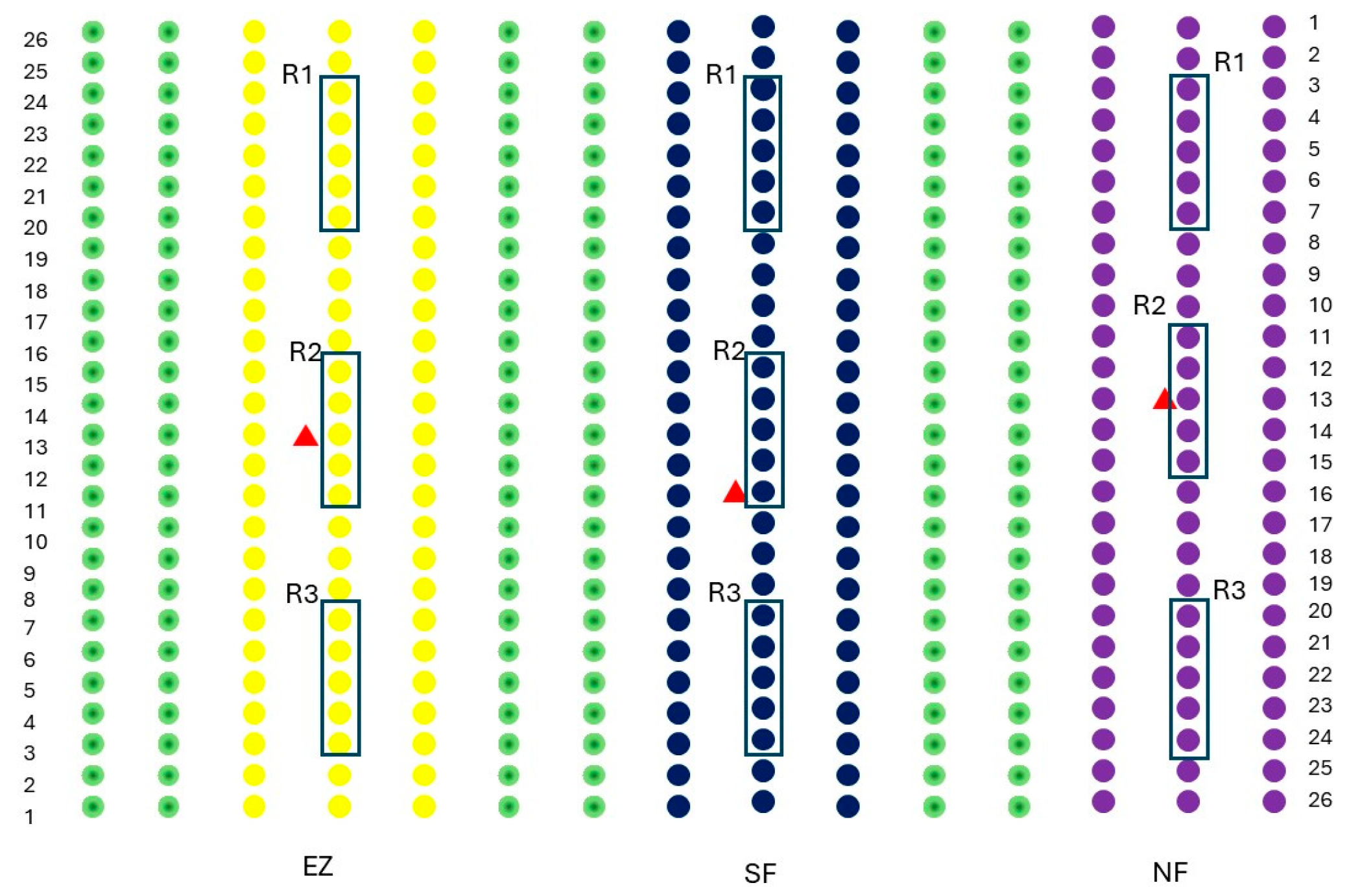
| Treatment | 19/7 | 2/8 | 4/9 | 16/9 | 1/10 |
|---|---|---|---|---|---|
| SF | 14.94 ± 3.62 a | 9.75 ± 2.08 b | 7.53 ± 1.53 b | 10.19 ± 2.05 b | 9.8 ± 2.25 b |
| NZ | 12.81 ± 1.45 b | 9.53 ± 1.46 b | 5.67 ± 3.08 b | 10.32 ± 2.7 b | 10.67 ± 1.05 ab |
| EZ | 15.95 ± 2.5 a | 12.81 ± 1.45 a | 10.17 ± 2.49 a | 12.54 ± 2.61 a | 12.1 ± 2.57 a |
| Treatment | δ13C | δ15N | TC% | TN% |
|---|---|---|---|---|
| SF | −26.04 ± 0.32 a | 0.36 ± 0.78 ab | 47.61 ± 3.68 a | 1.42 ± 0.12 a |
| NZ | −28.79 ± 5.04 a | 2.37 ± 1.24 a | 50.84 ± 6.11 a | 1.45 ± 0.16 a |
| EZ | −25.92 ± 0.37 a | −0.76 ± 0.49 b | 41.5 ± 6.18 a | 1.26 ± 0.24 a |
| RT | NZ | EZ | SF | |
|---|---|---|---|---|
| Alcohol | ||||
| 2-Ethylhexanol | 17.13 | 0.628 ± 0.217 a | 0.385 ± 0.115 a | 0.301 ± 0.038 a |
| Aldehyde | ||||
| 2-Butenal | 4.05 | 0.067 ± 0.021 a | 0.035 ± 0.044 a | 0.252 ± 0.195 a |
| Hexanal | 9.32 | 0.041 ± 0.017 a | 0.018 ± 0.003 a | 0.012 ± 0.006 a |
| Benzaldehyde | 14.38 | 0.084 ± 0.044 b | 0.083 ± 0.013 b | 0.214 ± 0.012 a |
| Nonanal | 19.16 | 0.255 ± 0.114 a | 0.12 ± 0.002 ab | 0.026 ± 0.024 b |
| Decanal | 21.99 | 0.187 ± 0.09 a | 0.103 ± 0.013 ab | 0.026 ± 0.009 b |
| Alkane | ||||
| Heptane | 6.61 | 0.049 ± 0.03 a | 0.064 ± 0.001 a | 0.057 ± 0.02 a |
| Octane | 9.84 | 0.107 ± 0.027 b | 0.123 ± 0.022 ab | 0.172 ± 0.005 a |
| Nonane | 13.35 | 0.142 ± 0.053 a | 0.1 ± 0.009 a | 0.172 ± 0.011 a |
| 2,2-Dimethylundecane | 16.61 | 0.075 ± 0.042 a | 0.038 ± 0.005 a | 0.049 ± 0.002 a |
| 2-Methylnonane | 16.58 | 0.126 ± 0.041 a | 0.09 ± 0.011 a | 0.061 ± 0.01 a |
| 3-Methylhexane | 19.62 | 0.127 ± 0.042 a | 0.051 ± 0.002 a | 0.069 ± 0.009 a |
| Decane | 22.37 | 0.139 ± 0.032 a | 0.067 ± 0.015 b | 0.071 ± 0.013 b |
| 2-Methyldodecane | 24.92 | 0.058 ± 0.033 a | 0.03 ± 0.009 a | 0.029 ± 0.005 a |
| 2,3-Dimethylpentane | 27.29 | 0.12 ± 0.041 a | 0.089 ± 0.026 a | 0.083 ± 0.003 a |
| Undecane | 29.52 | 0.309 ± 0.086 a | 0.176 ± 0.073 a | 0.148 ± 0.032 a |
| 2-Methyltridecane | 33.62 | 0.052 ± 0.028 a | 0.046 ± 0.017 a | 0.047 ± 0.02 a |
| Arene | ||||
| Benzene | 5.38 | 0.082 ± 0.021 a | 0.062 ± 0.021 a | 0.107 ± 0.018 a |
| Toluene | 8.22 | 0.241 ± 0.043 ab | 0.304 ± 0.036 ab | 0.206 ± 0.013 b |
| Ethylbenzene | 11.47 | 0.028 ± 0.006 a | 0.035 ± 0.008 a | 0.002 ± 0.001 b |
| p-Xylene | 11.77 | 0.075 ± 0.004 a | 0.08 ± 0.011 a | 0.035 ± 0.007 b |
| o-Xylene | 12.54 | 0.031 ± 0.006 a | 0.032 ± 0.002 a | 0.016 ± 0.001 b |
| 1-Hydroxy Cumene | 18.5 | 0.129 ± 0.038 a | 0.054 ± 0.019 ab | 0.028 ± 0.004 b |
| Ketone | ||||
| Acetophenone | 17.75 | 0.048 ± 0.011 b | 0.036 ± 0.004 b | 0.17 ± 0.049 a |
| Aromatic Organic Compound | ||||
| Benzonitrile | 15.04 | nd | nd | 0.381 ± 0.044 |
| Phenol | ||||
| Phenol | 15.45 | 0.34 ± 0.084 a | 0.303 ± 0.007 a | 0.235 ± 0.015 a |
| First Collection | Second Collection | ||||||
|---|---|---|---|---|---|---|---|
| RT | NZ | EZ | SF | NZ | EZ | SF | |
| Alcohol | |||||||
| 2-Propanol | 3.57 | 0.039 ± 0.006 b | 0.027 ± 0.007 b | 0.058 ± 0.003 b | 0.049 ± 0.011 b | 0.053 ± 0.015 b | 0.086 ± 0.007 a |
| Aldehyde | |||||||
| Hexanal | 9.11 | 0.007 ± 0.001 c | 0.007 ± 0.001 c | 0.01 ± 0.001 c | 0.022 ± 0.001 a | 0.012 ± 0.001 b | 0.007 ± 0.001 c |
| Benzaldehyde | 14.33 | 0.007 ± 0.002 b | 0.006 ± 0.002 b | 0.021 ± 0.008 a | 0.008 ± 0.001 b | 0.007 ± 0.001 b | 0.004 ± 0.001 b |
| Octanal | 16.07 | tr | 0.003 ± 0.001 a | 0.002 ± 0.001 b | 0.003 ± 0.001 a | tr | tr |
| Nonanal | 19.09 | 0.008 ± 0.001 b | 0.011 ± 0.001 b | 0.015 ± 0.001 b | 0.045 ± 0.004 a | 0.014 ± 0.001 b | 0.017 ± 0.001 b |
| Decanal | 21.94 | tr | 0.002 ± 0.001 | 0.003 ± 0.001 a | 0.002 ± 0.001 a | nd | tr |
| Alkane | |||||||
| Octane | 9.78 | 0.021 ± 0.001 a | 0.012 ± 0.003 a | 0.027 ± 0.009 a | 0.031 ± 0.006 a | 0.012 ± 0.001 a | 0.021 ± 0.002 a |
| Nonane | 13.29 | 0.004 ± 0.001 a | nd | 0.003 ± 0.001 a | 0.002 ± 0.001 a | nd | nd |
| Undecane | 27.23 | 0.004 ± 0.001 c | 0.005 ± 0.001 b | 0.007 ± 0.001 a | 0.002 ± 0.001 d | nd d | 0.002 ± 0.001 d |
| Arene | |||||||
| Benzene | 5.34 | 0.002 ± 0.001 b | nd | 0.003 ± 0.001 b | 0.003 ± 0.001 b | 0.006 ± 0.001 a | 0.006 ± 0.001 a |
| Toluene | 8.18 | 0.003 ± 0.001 a | 0.002 ± 0.001 a | 0.005 ± 0.003 a | 0.004 ± 0.001 a | 0.004 ± 0.001 a | 0.005 ± 0.001 a |
| Ethylbenzene | 11.39 | 0.003 ± 0.001 b | nd | 0.003 ± 0.002 b | 0.003 ± 0.001 b | 0.003 ± 0.001 b | 0.006 ± 0.002 a |
| p-Xylene | 11.71 | 0.003 ± 0.001 a | nd | 0.005 ± 0.003 a | 0.003 ± 0.001 a | 0.002 ± 0.001 a | 0.006 ± 0.002 a |
| o-Xylene | 12.48 | tr | tr | tr | tr | tr | tr |
| Ester | |||||||
| cis-3 Hexenyl Acetate | 16.28 | 0.003 ± 0.001 b | 0.005 ± 0.002 a | 0.003 ± 0.001 b | 0.003 ± 0.001 a | 0.002 ± 0.001 b | tr |
| Ether | |||||||
| Ethyl Ether | 3.65 | 0.082 ± 0.033 a | 0.027 ± 0.013 a | 0.04 ± 0.008 a | 0.03 ± 0.016 a | 0.018 ± 0.009 a | 0.17 ± 0.074 a |
| Ketone | |||||||
| 2-Propanone | 3.54 | 0.092 ± 0.026 b | 0.061 ± 0.01 b | 0.177 ± 0.025 a | 0.081 ± 0.011 b | 0.08 ± 0.027 b | 0.112 ± 0.003 b |
| 2-Pentanone | 5.94 | 0.019 ± 0.002 b | nd | 0.013 ± 0.006 b | 0.008 ± 0.001 b | 0.007 ± 0.002 b | 0.032 ± 0.003 a |
| Monoterpenoid | |||||||
| Citronellol | 31.96 | nd | 0.001 ± 0.001 | 0.006 ± 0.004 | nd | nd | nd |
| Sesquiterpene | |||||||
| α-Copaene | 26.75 | nd | nd | 0.001 ± 0.001 a | 0.002 ± 0.001 a | 0.003 ± 0.001 a | 0.001 ± 0.001 a |
| Furan | |||||||
| Tetrahydrofuran | 4.76 | 0.048 ± 0.009 b | 0.041 ± 0.01 b | 0.064 ± 0.011 b | 0.082 ± 0.035 b | 0.054 ± 0.019 b | 0.268 ± 0.106 a |
| Aromatic Organic Compound | |||||||
| Benzonitrile | 15 | tr | 0.004 ± 0.001 | 0.004 ± 0.002 | 0.004 ± 0.001 | tr | tr |
| Phenol | |||||||
| Phenol | 15.41 | tr | tr | 0.006 ± 0.005 a | tr | tr | nd |
| Treatment | Free Acidity 1 | Peroxid Number 2 | k232 | k270 | C16 | C16:1 | C18 | C18:1 | C18:2 | C18:3 |
|---|---|---|---|---|---|---|---|---|---|---|
| SF | 0.13 | 8.00 | 1.86 | 0.11 | 13.89 | 1.26 | 2.24 | 72.97 | 8.35 | 0.51 |
| NZ | 0.14 | 5.60 | 2.17 | 0.17 | 13.77 | 1.29 | 2.35 | 73.74 | 7.53 | 0.56 |
| EZ | 0.13 | 8.30 | 1.78 | 0.10 | 13.77 | 1.33 | 2.05 | 73.59 | 7.95 | 0.52 |
| Treatment | Olfactory Olive Fruity | Olfactory Pleasant Flavors | Gustatory Olive Fruity | Bitter | Pungent | Grass | Gustatory Pleasant Flavors |
|---|---|---|---|---|---|---|---|
| SF | 4.9 | 3.4 | 3.7 | 3.5 b | 3.7 b | 1.5 b | 1.4 |
| NZ | 5.5 | 3.6 | 5.1 | 5.6 a | 5.3 a | 3.3 a | 3.0 |
| EZ | 4.9 | 3.4 | 4.5 | 3.8 b | 4.4 ab | 2.8 ab | 2.5 |
Disclaimer/Publisher’s Note: The statements, opinions and data contained in all publications are solely those of the individual author(s) and contributor(s) and not of MDPI and/or the editor(s). MDPI and/or the editor(s) disclaim responsibility for any injury to people or property resulting from any ideas, methods, instructions or products referred to in the content. |
© 2024 by the authors. Licensee MDPI, Basel, Switzerland. This article is an open access article distributed under the terms and conditions of the Creative Commons Attribution (CC BY) license (https://creativecommons.org/licenses/by/4.0/).
Share and Cite
Morrone, L.; Neri, L.; Facini, O.; Galamini, G.; Ferretti, G.; Rotondi, A. Influence of Chabazite Zeolite Foliar Applications Used for Olive Fruit Fly Control on Volatile Organic Compound Emission, Photosynthesis, and Quality of Extra Virgin Olive Oil. Plants 2024, 13, 698. https://doi.org/10.3390/plants13050698
Morrone L, Neri L, Facini O, Galamini G, Ferretti G, Rotondi A. Influence of Chabazite Zeolite Foliar Applications Used for Olive Fruit Fly Control on Volatile Organic Compound Emission, Photosynthesis, and Quality of Extra Virgin Olive Oil. Plants. 2024; 13(5):698. https://doi.org/10.3390/plants13050698
Chicago/Turabian StyleMorrone, Lucia, Luisa Neri, Osvaldo Facini, Giulio Galamini, Giacomo Ferretti, and Annalisa Rotondi. 2024. "Influence of Chabazite Zeolite Foliar Applications Used for Olive Fruit Fly Control on Volatile Organic Compound Emission, Photosynthesis, and Quality of Extra Virgin Olive Oil" Plants 13, no. 5: 698. https://doi.org/10.3390/plants13050698
APA StyleMorrone, L., Neri, L., Facini, O., Galamini, G., Ferretti, G., & Rotondi, A. (2024). Influence of Chabazite Zeolite Foliar Applications Used for Olive Fruit Fly Control on Volatile Organic Compound Emission, Photosynthesis, and Quality of Extra Virgin Olive Oil. Plants, 13(5), 698. https://doi.org/10.3390/plants13050698







